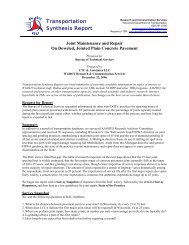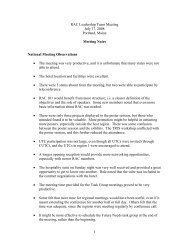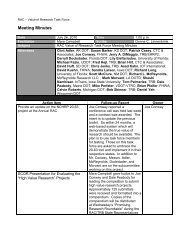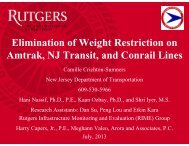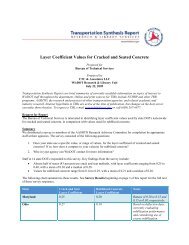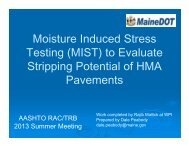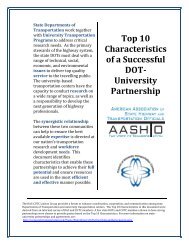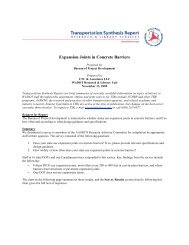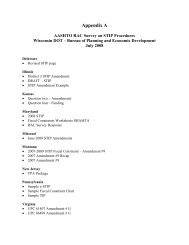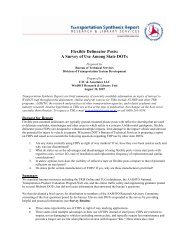PART IV: Summary of Comments - SCOR/RAC
PART IV: Summary of Comments - SCOR/RAC
PART IV: Summary of Comments - SCOR/RAC
Create successful ePaper yourself
Turn your PDF publications into a flip-book with our unique Google optimized e-Paper software.
<strong>PART</strong> <strong>IV</strong>: <strong>Summary</strong> <strong>of</strong> <strong>Comments</strong>17-May-10Reviewer <strong>Comments</strong> Distribution <strong>of</strong> RatingsItem #121:SP-03Develop Technologies for Unmanned Aircraft for StateDepartments <strong>of</strong> Transportation(17)(46)NR 0 1 2 3 4 5<strong>SCOR</strong> 1 2 4 7 1 2<strong>RAC</strong> 1 8 7 16 8 7 2Standing Committee on Research■ UAVs have been shown to have potential in several <strong>of</strong> the aplications mentioned in the proposal but have always hadnegative aspects that made them impractical for actual use. It is unclear what has changed to make this an appropriateproject now.■ Strongly support the development <strong>of</strong> the technology and applications to the transportation system. There are as many as44 companies and organizations currently developing Unmanned Aircraft (UAV) for use, the volume <strong>of</strong> informationavailable might suggest a Synthesis.■ existing in consultant community■ [Rating: 3] To summarize, while UAVs <strong>of</strong>fer some benefits, human interaction would lessen the potential for errors andproblems with regards to the use UAVs.Research Advisory Committee■ It is already known that UAV's can be used for remote sensing. The military does it daily. Identifying the potentialroadblocks to actually implement a UAV in a state DOT would be useful. Additionally, identifying a COTS(Commercial Off The Shelf) UAV that could carry the necessary payload (medium format digital camera, GPS/INS, etc)would give a good indication <strong>of</strong> the feasibility before attempting to design and build a UAV from scratch. The concept<strong>of</strong> a UAV for remote sensing within the DOT could be a reasonable alternative to traditional data collection usingmanned aircraft.■ WSDOT has explored the use <strong>of</strong> unmanned aircraft for avalanche control and is seeking funding for new research in thearea <strong>of</strong> rural traffic surveillance and accident investigation.■ Without cost comparisons with other similar data collection strategies, and an overall cost-benefit analysis, no need isseen■ There are many policy questions that should be addressed before serious consideration <strong>of</strong> funding for this project inapproved. These include: 1) In states with large amounts <strong>of</strong> tall growth vegetation (trees), the usefulness <strong>of</strong> this projectis doubtful; 2) In urban areas, the noise, take<strong>of</strong>f/landing areas and airspace restrictions may make the project resultsunworkable; 3) What data is so time-constrained that is must be acquired in this method and not via satellite or aerialphotography; and 4) The public may think this is government peering into their backyards and private lives - anotherpublic relations issue for the all-pervasive DOT. This project should be held until these overarching questions can beaddressed.Other■ [Rating: 2]Item #122:G-11Countdown Pedestrian Signals: Is the Flashing HandNecessary?(17)(46)NR 0 1 2 3 4 5<strong>SCOR</strong> 3 6 3 1 4<strong>RAC</strong> 7 10 11 13 8Standing Committee on Research■ Should be scaled down, simplified and considered for the TCD pool fund research. This effort has relevance particularlyas localities are upgrading pedestrian signal heads to provide countdowns. The costs associated with this project seemhigh.■ Suggest that Problem Statements G-11, G-17, G-24, G-33 and G-36 be combined.<strong>IV</strong>-89



